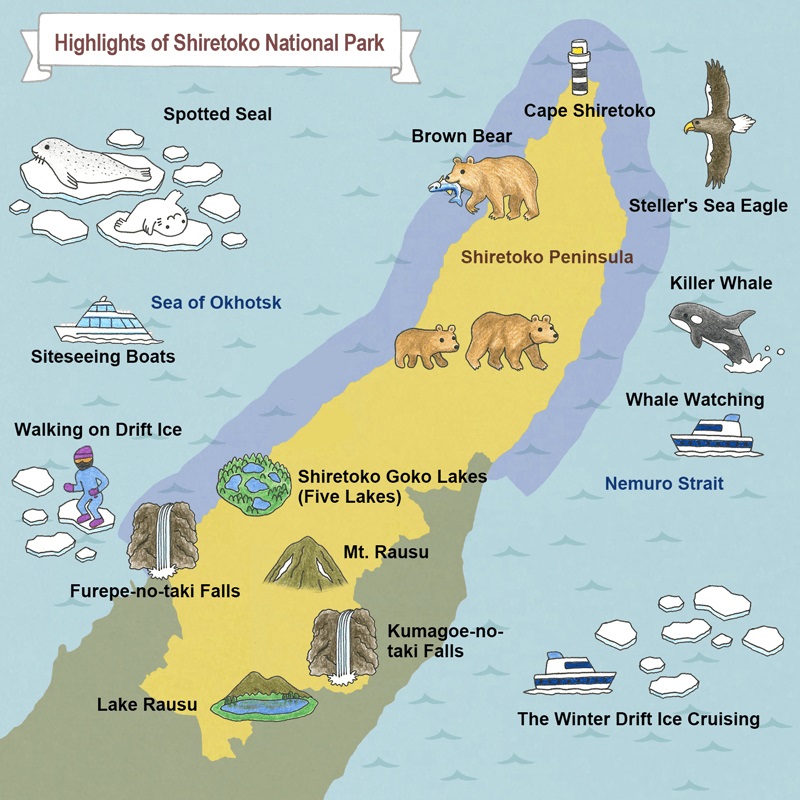- MOE
- National Parks of Japan
- Shiretoko National Park
- Guide of Highlights
main body
Highlights of Shiretoko National Park
Cape Shiretoko

Cape Shiretoko
Located at the tip of the Shiretoko Peninsula, Cape Shiretoko consists of vast grasslands that face the Sea of Okhotsk.
The area offers tour boat trips allowing visitors to enjoy views from the sea.
Frepe-no-taki Falls
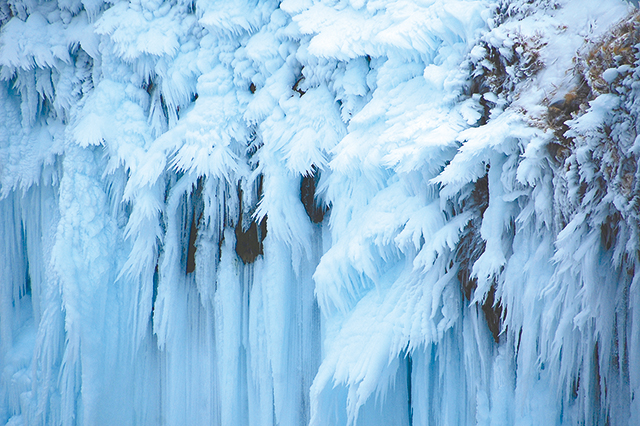
Frepe-no-taki Falls
Also known as the Maiden's Tears waterfall, the Frepe-no-taki Falls is characterized by underground water spraying out from a crack in the cliff. In winter, it is possible to go to see the frozen waterfall wearing snowshoes.
Shiretoko Goko Lakes (Five Lakes)
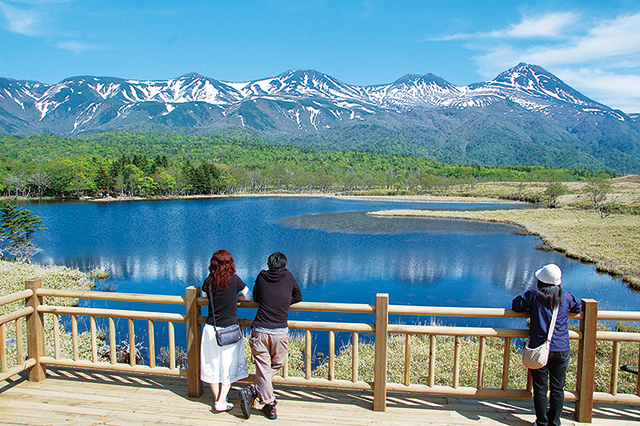
Shiretoko Goko Lakes (Five Lakes)
Visit each of these five magical lakes/marshes scattered through a primeval forest. The deep forests surrounding the lakes and Shiretoko Mountain Range rising above form a landscape representative of Shiretoko.
Kumagoe-no-taki Falls
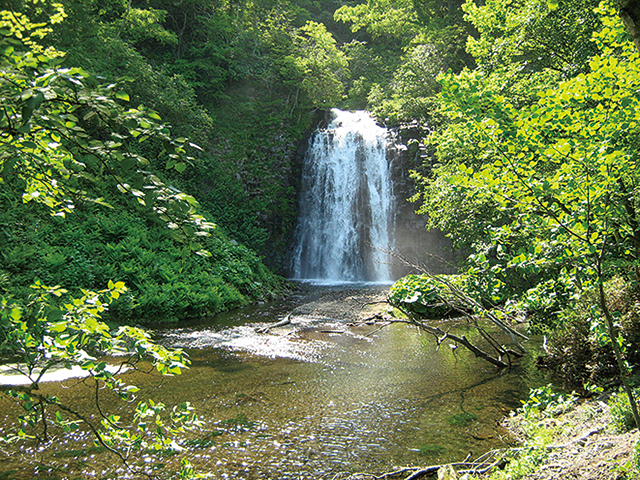
Kumagoe-no-taki Falls
This 15 m high waterfall is on the Rausu-River. The footpath entering from the Shiretokoodan-doro Road follows the fresh stream, where Ranunculus nipponicus var. submersus thrives.
Shiretoko Pass
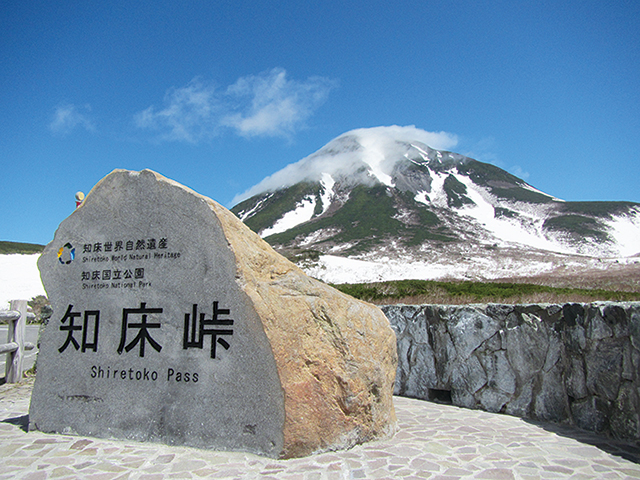
Shiretoko Pass
At a height of 738 m above sea level, Shiretoko Pass is the highest point along the Shiretokoodan-doro Road connecting Shari and Rausu Towns. The pass provides spectacular views of starry night skies and the morning sun rising over Kunashirito Island.*Closure during winter
Lake Rausu

Lake Rausu
The Lake Rausu Trail, which visits four large and small marshes before arriving at Lake Rausu, enables visitors to enjoy the marshes, mountains, and plant life all at once. The walk requires the same preparations as for mountain climbing.
Mt. Rausu

Mt. Rausu
From the peak of Mt. Rausu you have a magnificent view of the peninsula rising east-west from the ocean. Climbing this mountain is an eight-hour return trip and gorges remain filled with snow until late July, so thorough preparation and planning are necessary. The route from Rausu in particular is more suited to advanced climbers.
Wildlife & Plants
Viola kitamiana

Viola kitamiana
An alpine plant that is only found in Shiretoko, Etorofuto Island and Kunashirito Island, and is a symbol of Shiretoko. In June, the white flowers can be seen protruding from sand gravel surfaces in the Shiretoko Mountain Range.
Needleleaf and Broadleaf Tree Forest Populated with Sakhalin Fir and Other Trees

Needleleaf and Broadleaf Tree Forest Populated with Sakhalin Fir and Other Trees
The Shiretoko area is populated with mixed forests of needleleaf and broadleaf trees including Sakhalin fir, Jezo spruce and Mizunara and other trees.
Steller's Sea Eagle (Haliaeetus pelagicus)
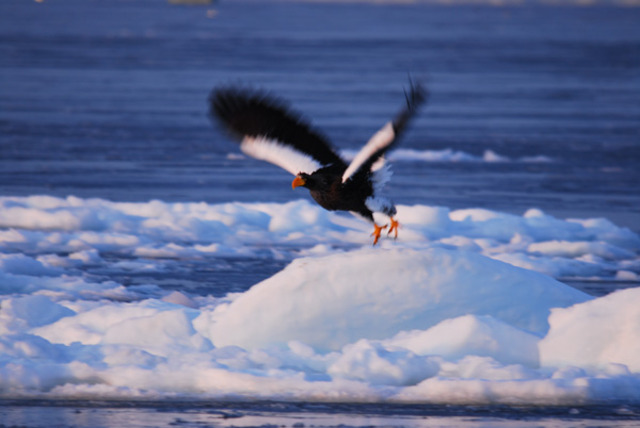
Steller's Sea Eagle (Haliaeetus pelagicus)
The Steller's sea eagle is an endangered large bird of prey that breeds on the Kamchatka Peninsula and in a few other areas.
It come to south to the Shiretoko Peninsula with drifting ice during the winter. In February, large numbers gather around the coastline of Rausu Town, where they hunt for fish overflowing from Walleye pollock fishery.
White-tailed Sea Eagle (Haliaeetus albicilla albicilla)

White-tailed Sea Eagle (Haliaeetus albicilla albicilla)
A large, endangered bird of prey, characterized by a white wedge shape on its tail. Some of the birds fly to Japan as winter birds between November and March, while others live and breed year-round in Shiretoko. The birds can be seen along the coast of the Shiretoko Peninsula.
Spotted Seal (Phoca largha)

Spotted Seal (Phoca largha)
A member of the seal family that comes to the Northern Hokkaido shore in winter to breed. Its name comes from the black spots dotting similar to black sesame seeds on its back hide. In Japanese, it is called "gomafuazarashi" or "darkly-mottled-seal" and can be seen in harbors and atop ice floes.
Killer Whale (Orcinus orca)

Killer Whale (Orcinus orca)
A member of the dolphin family, this animal can be seen off the shore of Shiretoko. Visitors to the Rausu Visitor Center can see an orca skeleton on display.
Brown Bear (Ursus arctos yezoensis)

Brown Bear (Ursus arctos yezoensis)
Japan's largest land mammal, this bear lives only in Hokkaido in Japan. Its population density in Shiretoko is among the highest in the world. Visitors to Shiretoko should understand the ecology of the brown bear and take care to avoid dangerous encounters.
Activities
Walking on Drift Ice
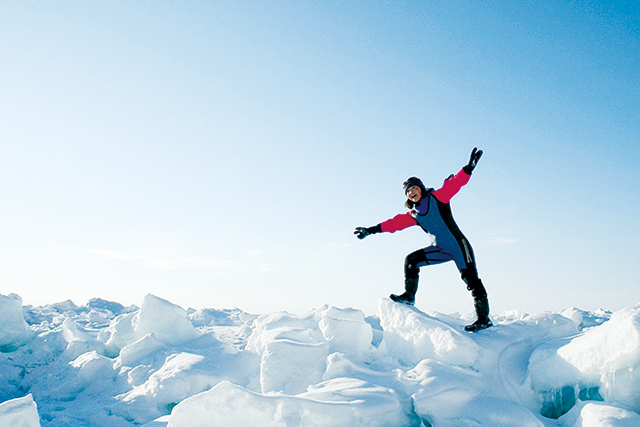
Walking on Drift Ice
Enabling participants to walk over drift ice with a guide and float in the cracks between the ice (wearing a special dry suit), this natural experience tour is unique to Shiretoko.
Sightseeing Boats
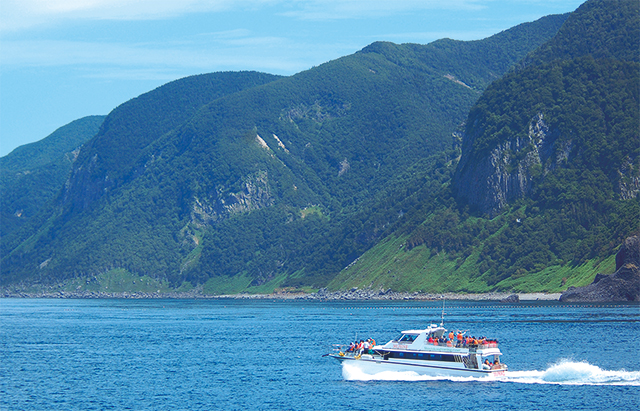
Sightseeing Boats
Departing from Utoro, these sightseeing boats provide not only spectacular views of cliffs and waterfalls, but also opportunities to observe brown bears, Spectacled Guillemots, and other wildlife.
The Winter Drift Ice Crusing
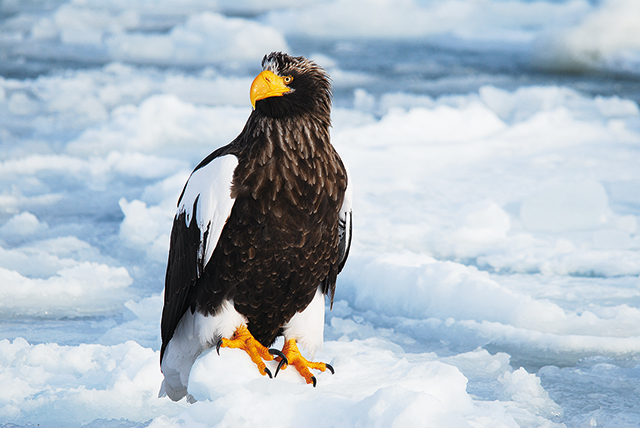
The Winter Drift Ice Crusing
Between February and April, it is possible to not only see the ice drifts on the ocean at Rausu, but also observe Steller's sea eagles, white-tailed sea eagles, spotted seals, and other wildlife up close.
Whale Watching
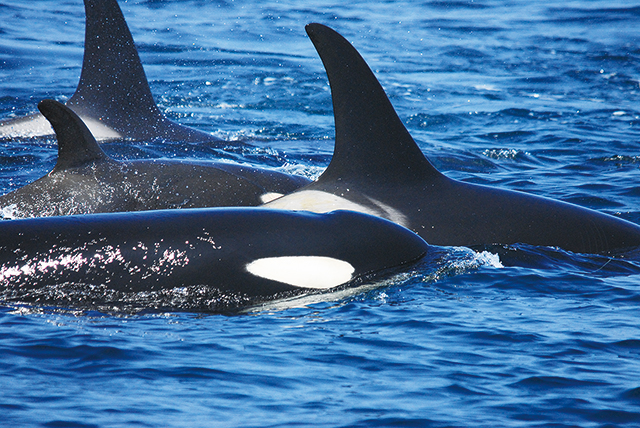
Whale Watching
The Nemuro Strait near Rausu is gaining attention as one of the best whale watching sites in Japan. Another attraction is that the whale species that can be observed change with the changing seasons.
